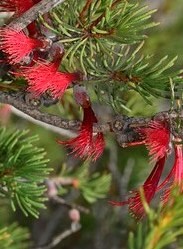Dense clawflower
(Melaleuca peucophylla)

Description
Calothamnus pinifolius, commonly known as dense clawflower, is a plant in the myrtle family, Myrtaceae and is endemic to the south-west of Western Australia. It is an erect shrub with dense foliage and clusters of red flowers, partly immersed in the prickly foliage, between July and January. Calothamnus pinifolius is an erect shrub that grows to 0.3–2.0 m (1–7 ft) high with a few long shoots and branches and a short shoot emerging from above the leaves of every long one. Its leaves are about 20–30 mm (0.8–1 in) long, crowded, thin and prickly. The flowers are in dense clusters, usually partly hidden by the foliage and have 4 sepals, 4 petals and 4 claw-like bundles of stamens about 25 mm (1 in) long. Flowering occurs between July and January. Flowering is followed by fruits which are woody capsules which have two prominent, curved lobes. Calothamnus pinifolius was first formally described in 1863 by Victorian Government botanist Ferdinand von Mueller in the third volume of Fragmenta Phytographiae Australiae. (In 2014 Lyndley Craven, Edwards and Cowley proposed that the species be renamed Melaleuca peucophylla.) The specific epithet (pinifolius) is from the Latin words pinus meaning "pine" and folium meaning "leaf". Calothamnus pinifolius occurs in the Mount Barren Range in the Esperance Plains biogeographic region. It grows on slopes in dense scrub in rocky soils derived from laterite and quartzite. Calothamnus is a genus of shrubs in the family Myrtaceae and is endemic to the south-west of Western Australia. The common names one-sided bottlebrush or claw flower are given to some species due to their having the flowers clustered on one side of the stem or because of the claw-like appearance of their flowers. Calothamnus species are generally medium to tall woody shrubs with crowded leaves. In most species the leaves are crowded and linear in shape, and the flowers are usually arranged in dense clusters. The petals are small and fall off the flower soon after it opens but the stamens are long, numerous and usually bright red.
Taxonomic tree:







